Important Questions for Class 12 Physics Chapter 15 Communication Systems Class 12 Important Questions
Communication Systems Class 12 Important Questions Very Short Answer Type
Question 1.
What is sky wave propagation? (Delhi 2009)
Answer:
Propagation of frequencies less than 40 MHz using the reflecting property of ionosphere is called Sky wave propagation.
Question 2.
What is ground wave propagation? (Delhi 2009)
Answer:
A radiowave that can travel directly from one point to another following the surface of the earth is called a ground wave propagation. Ground wave propagation is possible only when the transmitting and receiving antenna are close to the surface of the earth.
Question 3.
What is space wave propagation? (Delhi 2009)
Answer:
When the signal travels in a straight line from the transmitting antenna to the receiving antenna with frequencies more than 40 MHz, it is called space-wave propagation. Space waves are used for line of sight (LOS) communication as well as satellite communication.
Question 4.
What is the function of a repeater used in communication system? (Comptt. Delhi 2012)
Answer:
The function of a repeater in communication system is to extend the range of communication.
Question 5.
What does the term ‘attenuation’ used in communication system mean? (Comptt. Delhi 2012)
Answer:
Attenuation used in communication system means loss of strength of a signal during its propagation through the communication channel.
Question 6.
What is the function of a transducer used in a communication system? (Comptt. Delhi 2012)
Answer:
Transducer : Any device/arrangement that converts one form of energy into another is called a transducer.
Question 7.
The carrier wave is given by C(t) = 2 sin (8πt) volt
The modulating signal is a square wave as shown. Find modulation index. (Delhi 2012)
Answer:![]()
[Hint: Comparing the general expression for a wave C(f) = a sin ωt with the expression given here, we get the value of amplitude of carrier wave (Ac) = 2 volts.
In the diagram shown here for modulating signal, amplitude of modulating signal (Am) is 1 volt]
Question 8.
The given figure shows the block diagram of a generalized communication system. Identify the element labelled ‘X’ and write its function. (Delhi 2012)
Answer:
X = Channel
Function: The physical path between the transmitter and reciver is known as the communication channel. It comprises of the wire links, wireless and optic fibres.
Question 9.
The carrier wave is represented by C(t) = 5 sin (10πt) volt.
A modulating signal is a square wave as shown. Determine modulation index. (Delhi 2012)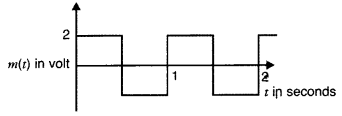
Answer:
Similar to Q. 7, Page 335 = 0.4
Question 10.
Tire carrier wave of a signal is given by C(t) = 3 sin (8πt) volt.
The modulating signal is a square wave as shown. Find its modulation index. (Delhi 2012)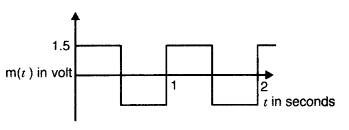
Answer:
Similar to Q. 7, Page 335![]()
Question 11.
How does the effective power radiated from a linear antenna depend on the wavelength of the signal to be transmitted? (Comptt. Delhi 2012)
Answer:
Effective power radiated decreases with an increase in wavelength, i.e.,![]()
Question 12.
Draw a block diagram of a detector for amplitude modulated signal. (Comptt. Delhi 2012)
Answer:
Question 13.
What is the meaning of the term ‘attenuation’ used in communication system? (Comptt. Delhi 2012)
Answer:
‘Attenuation’ means the loss of strength of a signal while propagating through the medium.
Question 14.
Give one example of point-to-point communication mode. (Comptt. All India 2012)
Answer:
Example of point-to-point communication mode : Telephone
Question 15.
Give one example of broadcast mode of communication. (Comptt. All India 2012)
Answer:
- Radio
- Television (any one)
Question 16.
Define the term ‘modulation index’ in communication system. (Comptt. All India 2012)
Answer:
Modulation index is defined as the ratio of amplitude of modulating signal to the amplitude of carrier wave, i.e.,![]()
Question 17.
What does the term ‘demodulation’ in communication system mean? (Comptt. All India 2012)
Answer:
Demodulation is the process of retrieval of information from the carrrier wave at the receiver end.
Question 18.
Distinguish between ‘point-to-point’ and ‘broadcast’ modes of communication. (Comptt. All India 2012)
Answer:
In a point-to-point communication, the communication takes place over a single link between transmitter and receiver, whereas, in the broadcast mode, there are a large number of receivers corresponding to a single transmitter.
Question 19.
How are side bands produced? (Delhi 2012)
Answer:
Side bands are produced due to superposition of carrier waves of frequencey cof over modulating/ Audio signal of frequency com; with the frequencies (ωc ± ωm).
Question 20.
Which basic mode of communication is used for telephonic communication? (All India 2012)
Answer:
Point to point communication mode is used for telephonic communication.
Question 21.
Why is the frequency of outgoing and incoming signals different in a mobile phone? (Comptt. Delhi 2012)
Answer:
To avoid overlapping of signals.
Question 22.
Distinguish between amplitude modulation and frequency modulation. (Comptt. All India 2012)
Answer:
The amplitude modulation provides a larger coverage area, while frequency modulation provides a better quality transmission.
Question 23.
Write two factors which justify the need of modulating a low frequency signal into high frequencies before transmission. (All India 2012)
Answer:
Need of modulating a low frequency signal :![]()
(ii) Transmission of audio frequency electrical signals need long impracticable antenna.
(iii) To avoid mixing-up of signals from different transmitters.
Question 24.
Name the essential, components of a communication system. (All India 2016)
Answer:
Transmitter, medium (channel) and receiver are three essential components of communication system.
Question 25.
Write the full forms of the terms :
(i) LAN
(ii) WWW (Comptt. Delhi 2017)
Answer:
(i) Local Area Networking
(ii) World Wide Web
Question 26.
Name the two basic modes of communication system. (Comptt. All India 2017)
Answer:
- Point to Point Communication and
- Broadcast are the two basic modes of communication.
Question 27.
Define modulation index. Why is it generally kept less than one? (Comptt. All India 2017)
Answer:
Modulation index is defined as the ratio of amplitude of modulating signal (Am) to amplitude of carrier wave (Ac)![]()
It is kept less than one to avoid distortion
Question 28.
Why is sky wave propagation of signals restricted to a frequency of 30 MHz? (Comptt. All India 2017)
Answer:
Sky wave propagation of signals is restricted to a frequency of 30 MHz, because waves of frequency greater than 30 MHz get penetrated through the ionosphere and thus they do not get reflected by it.
Question 29.
State two reasons why high frequency carrier waves are needed in transmitting a message signal. (Comptt. All India 2017)
Answer:
For the following reasons, high frequency carrier waves are needed in transmitting a message signal :
- Length of transmitting antenna is short.
- Power radiated is more.
- Mixing of signals can be avoided.
Communication Systems Class 12 Important Questions Short Answer Type SA-I
Question 30.
A transmitting antenna at the top of a tower has a height of 36 m and the height of the receiving antenna is 49 m. What is maximum distance between them, for satisfactory communication in the LOS mode? (Radius of earth = 6400 km) (Delhi 2017)
Answer:
dM = Maximum line of sight distance between the transmitting and receiving antennas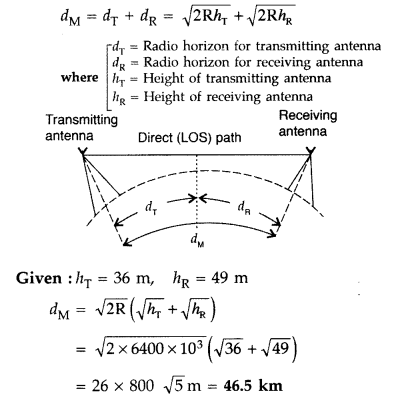
Question 31.
Draw a block diagram of a simple amplitude modulation. Explain briefly how amplitude modulation is achieved. (All India 2017)
Answer:
Production of Amplitude Modulated wave : A conceptually simple method to produce Am wave is shown in the following block diagram :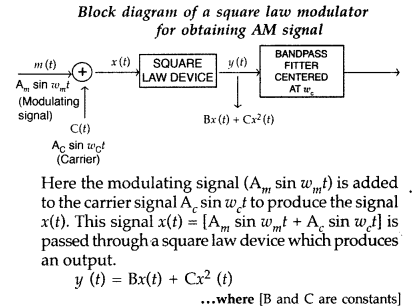
This signal is passsed through a band pass filter which rejects dc. The output of the band pass filter is therefore, Am wave
Question 32.
By what percentage will the transmission range of a TV tower be affected when the height of the tower is increased by 21%? (Delhi 2009)
Answer:
Range of a TV tower of height,

Question 33.
Why are high frequency carrier waves used for transmission? (Delhi 2008)
Answer:
- Radiation loss at low frequencies is more.
- Length of receiver antenna becomes very high for low frequency. So we use high frequency carrier waves for transmission.
Question 34.
What is meant by term ‘modulation’? Draw a block diagram of a simple modulator for obtaining an AM signal. (Delhi 2008)
Answer:
The process of placement or mounting of a low frequency signal over the high frequency signal is known as modulation.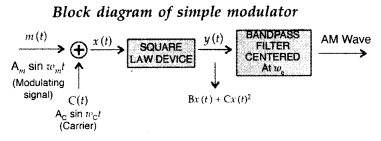
Question 35.
Answer the following questions :
(a) Optical and radio telescopes are built on the ground while X-ray astronomy is possible only from satellites orbiting the Earth. Why?
(b) The small ozone layer on top of the
stratosphere is crucial for human survival. Why? (All India 2017)
Answer:
(a) The earth’s atmosphere is transparent to visible light and radio-waves but it absorbs X-rays. X-ray astronomy is possible only from satellites orbitting the earth. These satellites orbit at a height of 36,000 km, where the atmosphere is very thin and X- rays are not absorbed.
(b) Ozone layer absorbs ultraviolet radiation from the Sun and prevents it from reaching the earth and thus avoids causing damage to life.
Question 36.
Write the function of
(i) Transducer and
(ii) Repeater in the context of communication system. (All India 2017)
Answer:
(i) Transducer : A transducer is a device which converts one form of energy into another.
(ii) Repeater : A repeater is a combination of receiver and transmitter used for extending the range of communication system.
Question 37.
Write two factors justifying the need of modulation for transmission of a signal. (All India 2017)
Answer:
- Length of receiving antenna (a wavelength) becomes practicable with larger frequency carrier wave used in the process of modulation.
- With larger frequency or reduced wavelength, the power radiated will be larger from the transmitter and the loss will be less.
Question 38.
Explain the function of a repeater in a communication system. (Delhi 2017)
Answer:
A repeater is a combination of a receiver and a transmitter. A repeater picks up the signal from the transmitter, amplifies and retransmits it to the receiver sometimes with a change in carrier frequency. Repeaters are used to extend the range of a communication system.
Question 39.
Explain the function of a repeater in a communication system. (Delhi 2017)
Answer:
A repeater is a combination of a receiver and a transmitter. A repeater picks up the signal from the transmitter, amplifies and retransmits it to the receiver sometimes with a change in carrier frequency. Repeaters are used to extend the range of a communication system.
Question 40.
What is the range of frequencies used for TV transmission? What is common between these waves and light waves? (Delhi 2017)
Answer:
Television frequencies lie in the range of 54-890 MHz which cannot be reflected by ionosphere. Both waves are electromagnetic waves and can travel through vaccum with same speed.
Question 41.
What is the range of frequencies used in satellite communication? What is common between these waves and light waves? (Delhi 2017)
Answer:
Range of frequencies used in satellite communication is :
uplink = 5.925 to 6.425 GHz and downlink = 3.7 to 4.2 GHz.
Both the waves uplink and downlink used in satellite communication and light waves are electromagnetic waves and can travel through vaccum with the same speed.
Question 42.
Write two factors justifying the need of modulating a signal.
A carrier wave of peak voltage 12 V is used to transmit a message signal. What should be the peak voltage of the modulating signal in order to have a modulation index of 75%? (All India 2017)
Answer:
(a) A signal requires modulation because :
(i) a modulated signal being of high frequency can be transmitted with the help of an antenna of reasonable size.
(ii) a modulated signal can be transmitted with more power because power radiated is proportional to 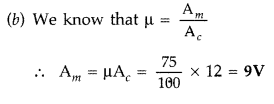
Question 43.
(i) Define modulation index.
(ii) Why is the amplitude of modulating signal kept less than the amplitude of carrier wave? (Delhi 2017)
Answer:
(i) Modulation index : The modulation index is defined as the ratio of the change in the amplitude of the carrier wave to the amplitude of the original carrier wave.![]()
(ii) The amplitude of modulating signal is kept less than the amplitude of carrier wave to avoid distortion.
Question 44.
What is sky wave communication? Why is this mode of propagation restricted to the frequencies only upto few MHz? (All India 2017)
Answer:
Sky wave communication : A radiowave directed towards the sky and reflected by the ionosphere . towards the desired location of the earth is called a sky wave. The ionospheric layers act as a reflector for a certain range of frequencies. Radio waves of frequencies between 3 MHz to 30 MHz can be reflected by the ionosphere. This mode of propagation is used by short wave broadcast service.
The propagation is restricted to the electro-magnetic waves of frequencies greater than 30 MHz because they penetrate the ionosphere and escape.
Question 45.
What is ground wave communication? On what factors does the maximum range of propagation in this mode depend? (All India 2017)
Answer:
Ground wave propagation : A radio wave that can travel directly from one point to another following the surface of the earth is called a ground wave. Groud wave propagation is possible only when the transmitting and receiving antenna are close to the surface of the earth.
The maximum range of ground wave propagation depends on two factors :
- The frequency of the transmitted wave, and
- The power of the transmitter.
Question 46.
What is space wave communication? Write the range of frequencies suitable for space wave communication? (All India 2017)
Answer:
When the signal travels directly from the transmitting antenna to the receiving antenna with frequencies more than 30 MHz, is called space wave communitaion.
High frequencies (above 40 MHz) can be transmitted through space wave propagation.
Question 47.
Distinguish between ‘Analog and Digital signals’. (Delhi 2017)
Answer:
Analog signal: A signal v- in which current or voltage varies continuously with time is called analog signal.
Example : Sinosidal wave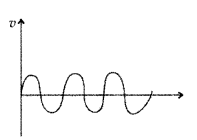
Digital signal : A signal in which current or voltage can take only two discrete values, is called a digital signal.
A digital signal can take only two values 1 and 0 which are labelled as high and low values.
Question 48.
Mention the function of any two of the following used in communication system:
(i) Transducer
(ii) Repeater
(iii) Transmitter
(iv) Bandpass Filter (Delhi 2017)
Answer:
(i) Transducer. It converts energy from one form to another.
(ii) Repeater. It picks up a signal from the transmitter, amplifiers and retransmits it to the receiver, sometimes with a change of carrier frequency.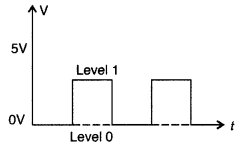
(iii) Transmitter. It is a device which processes a message signal into a form suitable for transmission and then transmits it to the receiving end through a transmission channel.
(iv) Bandpass filter. A bandpass filter blocks lower and higher frequencies and allows only a band of frequencies to pass through.
Question 49.
In the given block diagram of a receiver, identify the boxes labelled as X and Y and write their functions. (All India 2017)
Answer:
X ➝ IF (Intermediate frequency) stage
Y ➝ Amplifier/Power amplifier
Function of IF Stage : IF stage represents intermediate frequency stage preceding the detection. The carrier frequency is usually changed to a lower frequency by the IF stage.
Function of Amplifier : It is to amplify the signal i.e. to increase the strength of the input signal.
Question 50.
A carrier wave of peak voltage 12 V is used to transmit a message signal. Calculate the peak voltage of the modulating signal in order to have a modulation index of 75%.(Comptt. Delhi 2017)
Answer:
Question 51.
(a) Identify the boxes, ‘P’ and ‘Q’ in the block diagram of a receiver shown in the figure.
(b) Write the functions of the blocks ‘P’ and ‘Q’. (Comptt. Delhi 2017)
Answer:
(a) ‘P’ is IF (Intermediate frequency) Stage.
‘Q’ is Detector.
(b) IF stage represents intermediate frequency stage preceding the detection, the carrier frequency is usually changed to a lower frequency by the IF stage. Detection is the process of recovering the modulating signal from the modulated carrier wave.
Question 52.
A carrier wave of peak voltage 18 V is used to transmit a message signal. Calculate the peak voltage of the modulating signal in order to have a modulation index of 50%.(Comptt. Delhi 2017)
Answer:
Question 53.
A carrier wave of peak voltage 15 V is used to transmit a message signal. Calculate the peak voltage of the modulating signal in order to have a modulation index of 60%.(Comptt. Delhi 2017)
Answer:
Question 54.
Which mode of wave propagation is suitable for television broadcast and satellite communication, and why? Draw a suitable diagram depicting this mode of propagation of wave. (Comptt. All India 2017)
Answer:
Space wave propagation is suitable for television broadcast and satellite communication.
Reason: These waves, having frequency > 40 MHz, are not likely to be reflected back by the ionosphere.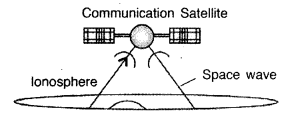
Question 55.
Block diagram of a receiver is shown in the figure :
(a) Identify ‘X’ and ‘Y’.
(b) Write their functions (Delhi 2013)
Answer:
X is IF stage (intermediate frequency stage).
Function: The carrier frequency is changed to a lower frequency by intermediate frequency (IF) stage preceding the detection. .
Y is Amplifier.
Function : To strengthen the detected signal, it is fed to an amplifier.
Question 56.
In the block diagram of a simple modulator for obtaining an AM signal, shown in the figure, identify the boxes A and B. Write their functions. (All India 2013)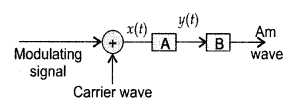
Answer:
Box A is square law device while Box B is band pass filter centred at ωc.
Function of (A) square law device :
It is a non-linear device which gives an output in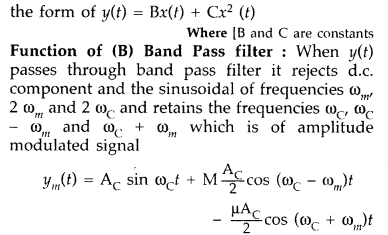
Question 57.
A message signal of frequency 10 kHz and peak voltage 10 V is used to modulate a carrier of frequency 1 MHz and peak voltage 20 V. Determine
(i) the modulation index,
(ii) the side bands produced. (Comptt. Delhi 2013)
Answer: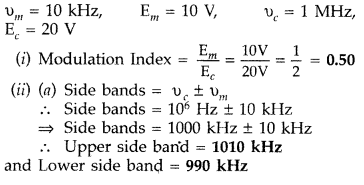
Question 58.
Explain briefly how ground waves are propagated? Why can’t this mode be used for long distance using high frequency?
(Comptt. All India 2013)
Answer:
When the radiowaves from the transmission antenna propagate along surface of the earth, so as to reach the receiving antena, these are known as ground waves propagation.
Ground waves are rapidly attenuated due to scattering by the curved surface of earth. It is why these cannot be used for long distances.
Question 59.
Explain briefly how sky waves are propagated. Why are sky waves not used for transmission of TV signals? (Comptt. All India 2013)
Answer:
Sky wave propagation. When the radio-waves from the transmitting antenna reach the receiving antenna after reflection in the ionosphere, the wave propaga-tion is called sky wave propagation.
Sky waves are not used in transmitting TV signals because of high frequency (> 80 MHz). These waves are not reflected back by the ionosphere and . penetrate into outer space.
Question 60.
Describe briefly the space wave mode of propagation. Name one transmission which uses space wave mode. (Comptt. All India 2013)
Answer:
Space wave propagation. When the radio-waves from the transmitting antenna reach the receiving antenna either directly or after reflection from the ground or in the troposphere, the wave propagation is called space wave propagation.
In practice, direct wave mode is more dominant. However, it is limited to the so called ‘line-of-sight’ transmission distances and curvature of earth as well as height of antenna restrict the extent of coverage.
TV transmission uses the space wave mode.
Question 61.
Write the functions of the following in communication systems :
(i) Transducer
(ii) Repeater (All India 2014)
Answer:
(i) Transducer : A transducer is a device which converts one form of energy into another.
(ii) Repeater : A repeater is a combination of receiver and transmitter used for extending the range of communication system.
Question 62.
Write the functions of the following in communication systems :
(i) Transmitter
(ii) Modulator (All India 2014)
Answer:
(i) Transmitter. A set-up that transmits the message to the receiver through a communication channel.
(ii) Modulator. A set-up which makes necessary modification of message signal to make it suitable for transmission to long distances through carrier waves.
Question 63.
Write the functions of the following in communication systems :
(i) Receiver
(ii) Demodulator (All India 2014)
Answer:
(i) Receiver. It extracts the desired message signals from the received signals at the channel output.
(ii) Demodulator. It is the set-up which makes the process of retrival of information from the carrier wave at the receiver. It is the reverse of ‘modulator’
Question 64.
Explain the terms
(i) Attenuation and
(ii) Demodulation used in communication system. (Delhi 2016)
Answer:
(i) The loss of strength of a signal while propagating through a medium is called ‘Attenuation’.
(ii) The process of separation of information signal from modulated wave at the receving end is called ‘Demodulation’.
Question 65.
Define modulation index. Why is it kept low? What is the role of a bandpass filter? (All India 2016)
Answer:
(i) Modulation index is the ratio of the amplitude of modulating signal to that of carrier wave and is given by
(ii) It is kept low to avoid distortion.
(iii) Role of bandpass filter is that it rejects low and high frequencies and allows a band of frequencies to pass through.
Question 66.
Distinguish between ‘Sky wave’ and ‘Space wave’ modes of propagation in a communication system. (Comptt. Delhi 2016)
Answer:
Distinction between ‘Sky Wave’ and ‘Space Wave’
| S.No. | Sky Wave | Space Wave |
| 1. Range of frequencies
| Restricted upto a few MHz frequency (30 to 40 MHz).
| Can take place (even) beyond 40 MHz frequency.
|
| 2. Mode of propagation
| Waves are reflected back from ionosphere.
| Space waves travel in a straight line, either direct from transmitting antenna to receiving antenna or through satellite.
|
Question 67.
Which basic mode of communication is used in satellite communication? What type of wave propagation is used in this mode? Write, giving reason, the frequency range used in this mode of propagation. (Delhi 2017)
Answer:
- Broadcast/point to point is the mode of communication used in satellite communication.
- Space wave propagation is used in this mode.
- The frequency range is above 40 MHz, because e.m. waves of frequency above 40 MHz, are not reflected back by the ionosphere and penetrate through the ionosphere.
Question 68.
Distinguish between a transducer and a repeater. (Delhi 2017)
Answer:
Transducer : A device which converts one form of energy into another.
Repeater : A combination of receiver and transmitter. It picks signals from a transmitter; amplifies and retransmits them.
Question 69.
(i) What is the line of sight communication?
(ii) Why is it not possible to use sky waves for transmission of TV signals? tJpto what distance can a signal be transmitted using an antenna of height ‘h’ (Delhi 2017)
Answer:
(i) Communication, using waves which travels in straight line from transmitting antenna to receiving antenna, constitutes line of sight communication.
(ii) (a) We cannot use sky waves because T.V. . signal waves are not reflected back by the ionosphere.
(b) d =
Question 70.
State the two points to distinguish between sky wave and space wave modes of propagation. (Comptt. All India 2017)
Answer:
Distinction between ‘Sky Wave’ and ‘Space Wave’
| S.No. | Sky Wave | Space Wave |
| 1. Range of frequencies
| Restricted upto a few MHz frequency (30 to 40 MHz).
| Can take place (even) beyond 40 MHz frequency.
|
| 2. Mode of propagation
| Waves are reflected back from ionosphere.
| Space waves travel in a straight line, either direct from transmitting antenna to receiving antenna or through satellite.
|
Question 71.
Distinguish between point-to-point and broadcast modes of communication. Give one example for each. (Comptt. All India 2017)
Answer:
Point to point communication takes place between a single transmitter and a receiver; While in broadcast mode, a large number of receivers can receive signal from a single transmitter.
Example of point to point mode : telephony Example of broadcast mode : Radio/TV
Communication Systems Class 12 Important Questions Short Answer Type SA-II
Question 72.
Draw a plot of the variation of amplitude versus ω for an amplitude modulated wave. Define modulation index. State its importance for effective amplitude modulation. (Delhi 2017)
Answer:
(i) Plot of ‘amplitude’ versus ‘ω’ for an amplitude modulated signal
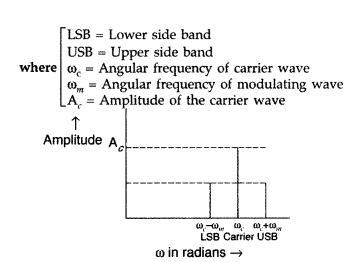
(ii) Modulation index : It is the ratio of amplitude of message or modulating signal to the amplitude of the carrier wave
(iii) Importance :
- Modulation index determines the strength and quality of the transmitted signal.
- Distortions are avoided by keeping p < 1.
Question 73.
Explain, why high frequency carrier waves are needed for effective transmission of signals.
A message signal of 12 kHz and peak voltage 20 V is used to modulate a carrier wave of frequency 12 MHz and peak voltage 30 V. Calculate the
(i) modulation index
(ii) side-band frequencies. (All India 2017)
Answer:
(a) With high frequency carrier waves
- transmission can take place with reasonable antenna length.
- as power radiated is proportional to 1/λ2, power radiation increases.
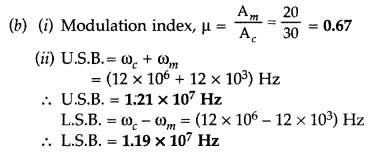
Question 74.
Distinguish between sky wave and space wave propagation. Give a brief description with the help of suitable diagrams indicating how these waves are propagated. (All India 2017)
Answer:
Sky wave propagation involves frequencies in the range 30 to 40 MHz and ionospheric reflection. Space wave propagation facilitates line of sight communication at frequencies more than 40 MHz. For the space wave to be received beyond the horizon, the receiving antenna of higher lengths are used.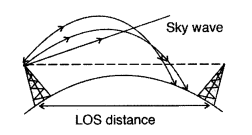
Question 75.
What is space wave propagation? Give two examples of communication system which use space wave mode.
A TV tower is 80m tall. Calculate the maximum distance upto which the signal transmitted from the tower can be received. (Delhi 2017)
Answer:
If a radiowave transmitted from an antenna, travelling in a straight line, directly reaches the receiving antenna, it is called a space wave and the wave propagation is called space wave propagation.
Space waves used for line of sight (LOS) communication as well as satellite communication travels in straight line from transmitting antenna to the receiving antenna.
The figure shows the communication by LOS. If height of transmitting and receiving antenna are hT and hR, the maximum distance dM between two antenna is given by
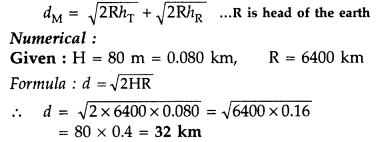
Question 76.
(i) Why is communication using line of sight mode limited to frequencies above 40 MHz?
(ii) A transmitting antenna at the top of a tower has a height 32 m and the height of the receiving antenna is 50 m. What is the maximum distance between them for satisfactory communication in line of sight mode? (Delhi 2017)
Answer:
(i) It is evident that above 40 MHz frequencies, the size of transmitting and receiving antenna reduces and has to be placed at a sufficient . height from the ground. Whereas below this
frequency, the waves from transmitting antenna get interrupted and blocked at many points by curvature of earth.
(ii) Given : hT = 32 m, hR = 50 m,
R = 6400 = 64 × 105 m
Maximum line of sight distance dm between the transmitting antenna and receiving antenna is given by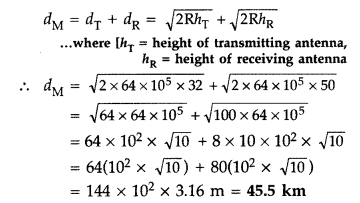
Question 77.
Which mode of propagation is used by short wave broadcast services having frequency range from a few MHz upto 30 MHz? Explain diagrammatically how long distance communication can be achieved by this mode. Why is there an upper limit to frequency of waves used in this mode? (All India 2017)
Answer:
(a) Sky wave propagation is used by Broadcast services.
(b) As signals get reflected back to the earth (due to internal reflection) from 65 km to 100 km above its surface range of transmission g increases from ionosphere.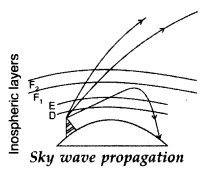
(c) Electromagnetic waves of frequencies higher than 30 MHz, penetrate the ionosphere and escape.
Question 78.
Draw a schematic diagram showing the
(i) ground wave
(ii) sky wave and
(iii) space wave propagation modes for em waves.
Write the frequency range for each of the following :
(i) Standard AM broadcast
(ii) Television
(iii) Satellite communication (Delhi 2011)
Answer: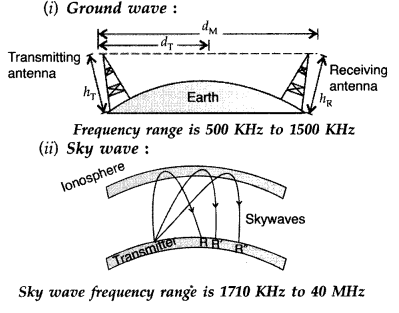
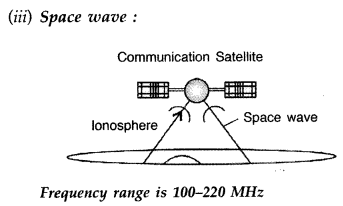
Frequency range is 100-220 MHz Frequency range for
(i) Standard AM broadcast 540-1600 kHz
(ii) Televisiuon 54-890 MHz
(iii) Satellite communication
5.925-6.425 GHz Uplink
3.7-4.2 GHz Downlink
Question 79.
Write briefly any two factors which demonstrate the need for modulating a signal.
Draw a suitable diagram to show amplitude modulation using a sinusoidal signal as the modulating signal. (All India 2011)
Answer:
Need for modulation :
(i) Audio frequencies below 20 kHz are poor to radiate. They die out after covering small distance in air. Hence they cannot travel large distance from the point of transmission.
(ii) To transmit audio waves, a very small antenna is needed. For example, if a 15 kHz signal is to be broadcasted then it requires a vertical antenna of heights 5 km which is impossible to think even.
Diagram showing amplitued modulation:
Question 80.
Write any three factors which justify the need for modulating a signal.
Draw a diagram showing an amplitude modulated wave by superposing a modulating signal over a sinusoidal carrier wave. (Delhi 2012)
Answer:
Need for modulation:
(i) Size of an tenna: For transmitting a signal, an antennaa or an aerial of a practical size comparable to the wavelength of the signal is required. If 15 kHz signal is to be broadcasted then it requires a vertical antenna of height 5 km which is impossible to even think off.
(ii) Effective power radiated by an antenna: Audio frequencies are below 20 kHz. The low frequencies are poor to radiate. They die out after covering small distance in air. For good transmission, high powers and high frequency transmission is needed.
(iii) Mixing up of signals from different transmitters : If many transmitters are transmitting message signals simultaneously, all these signals will get mixed up and it will be difficult to distinguish between them.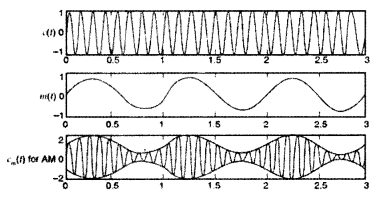
Question 81.
Name the three different modes of propagation of electromagnetic waves. Explain, using a proper diagram the mode of propagation used in the frequency range above 40 MHz. (Delhi 2012)
Answer:
The modes of propagation of electromagnetic waves are :
(i) Ground waves
(ii) Sky waves
(iii) Space waves
Above 40 MHz, the mode of propagation used is via space waves. A space wave travels in a straight line from the transmitting antenna to the receiving antenna. Space waves are used for line of sight (LOS) communications as well as satellite communication.
Question 82.
Mention three different modes of propagation used in communication system. Explain with the help of a diagram how long distance communication can be achieved by ionospheric reflection of radio waves. (All India 2012)
Answer:
Three different modes of propagation used in communication are :
(i) Space wave propagation.
(ii) Ground wave propagation
(iii) Sky wave or ionospheric propagation
The radio waves of the high frequency band having frequency range 3-30 MHz cannot penetrate through the ionosphere. They are reflected back towards the earth. This region of the AM band is called short wave band. Above 40 MHz, the ionosphere bends the electromagnetic waves and does not reflect them back towards the earth.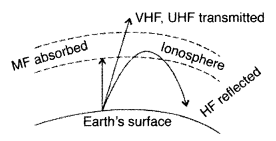
Question 83.
Explain briefly the following terms used in communication system :
(i) Transducer
(ii) Repeater
(iii) Amplification (All India 2012)
Answer:
(i) Transducer: Any device which converts energy from one form to another is called a transducer. We may define an electrical transducer as a device which converts variation in physical quantity such as pressure, displacement, force, temperature etc., into corresponding variations in the electrical signal at its output.
(ii) Repeater: As signal while passing through the transmission medium may get attenuated due to the various energy losses along its path. So a signal booster or amplifying repeater is placed at suitable distance along its path. A repeater is a combination of a transmitter, an amplifier and a receiver which picks up a signal from the transmitter, amplifiers and retransmits it to the receiver sometimes with a change of carrier frequency.
(iii) Amplification : It is the process of increasing the amplitude and hence the strength of an electrical signal by using a suitable electric circuit (consisting of atleast one transistor) is called the amplifier.
Question 84.
(a) Distinguish between sinusoidal and pulse-shaped signals.
(b) Explain, showing graphically, how a sinu-soidal carrier wave is superimposed on a modulating signal to obtain the resultant amplitude modulated (AM) wave. (Comptt. All India 2012)
Answer: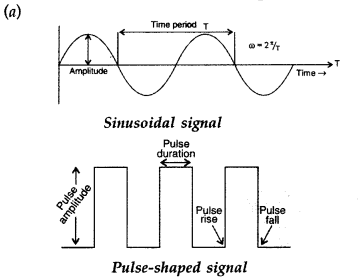
| Sinusoidal signal | Pulse-shaped signals |
| In a sinusoidal signal, the value of its characteristic parameter (voltage, current etc.) varies with time in the same manner as sin θ varies with θ. | In a pulse-shaped signal, the value of its characteristic parameter (voltage, current etc.), after remaining (nearly) constant for a small time interval, suddenly reverses its sign, remains constant for a small time interval and then again reverses its sign. This gets repeated again and again. |
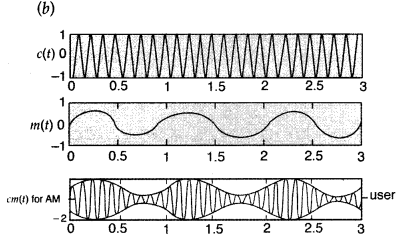
When a modulating signal (Figure b) is superimposed on sinusoidal carrier wave (Figure a), and as a result, the amplitude of the carrier wave varies in accordance with the modulating signal, the resultant wave (Figure c) is known as an amplitude modulated wave.
Question 85.
Write three important factors which justify the need of modulating a message signal. Show diagrammatically how an amplitude modulated wave is obtained when a modulating signal is superimposed on a carrier wave. (Delhi 2013)
Answer:
Need for modulation:
(i) Size of an tenna: For transmitting a signal, an antennaa or an aerial of a practical size comparable to the wavelength of the signal is required. If 15 kHz signal is to be broadcasted then it requires a vertical antenna of height 5 km which is impossible to even think off.
(ii) Effective power radiated by an antenna: Audio frequencies are below 20 kHz. The low frequencies are poor to radiate. They die out after covering small distance in air. For good transmission, high powers and high frequency transmission is needed.
(iii) Mixing up of signals from different transmitters : If many transmitters are transmitting message signals simultaneously, all these signals will get mixed up and it will be difficult to distinguish between them.
Question 86.
Distinguish between ‘sky waves’ and ‘space waves’ modes of propagation in communication system.
(a) Why is sky wave mode propagation restricted to frequencies upto 40 MHz?
(b) Give two examples where space wave mode of propagation is used. (Delhi 2013)
Answer:
Difference between skywave and space wave modes :
| S.No. | Sky Wave | Space Wave |
| 1. Range of frequencies
| Restricted upto a few MHz frequency (30 to 40 MHz).
| Can take place (even) beyond 40 MHz frequency.
|
| 2. Mode of propagation
| Waves are reflected back from ionosphere.
| Space waves travel in a straight line, either direct from transmitting antenna to receiving antenna or through satellite.
|
(a) The radio waves of frequencies more than 40 MHz penetrate into the ionosphere.
(b) Television broadcast, microwave link and satellite communication.
Question 87.
Name the type of waves which are used for line of sight (LOS) communication. What is the range of their frequencies?
A transmitting antenna at the top of a tower has a height of 20 m and the height of the receiving antenna is 45 m. Calculate the maximum distance between them for satisfactory communication in LOS mode. (Radius of the Earth = 6.4 × 106 m) (All India 2013)
Answer:
(i) Space waves
(ii) More than 50 Hz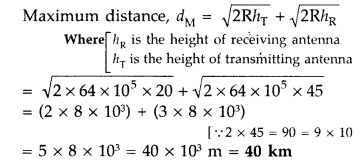
Question 88.
Name the type of waves which are used for line of sight (LOS) communication. What is the range of their frequencies?
A transmitting antenna at the top of a tower has a height of 45 m and the receiving antenna is on the ground. Calculate the maximum distance between them for satisfactory communication in LOS mode. (Radius of the Earth = 6.4 ∞ 106 m) (All India 2013)
Answer:
• Space waves
• Frequency range above 40 MHz
Question 89.
What is meant by ‘detection of a modulated signal’? Draw block diagram of a detector for AM waves and state briefly, showing the waveforms, how the original message signal is obtained. (Comptt. Delhi 2013)
Answer:
Detection of a modulated signal: Detection is the process of recovering the modulated signal from the modulated carrier wave. The modulated carrier wave contains the frequencies <oc, eoc+ com and In order to obtain the original message signal m (+) of angular frequency com following simple method is shown in the form of a block diagram.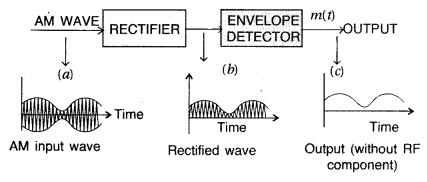
Question 90.
Write the function of each of the following used in communication sytem :
(i) Transducer
(ii) Repeater
(iii) Transmitter (Comptt. Delhi 2013)
Answer:
(i) Transducer. It converts energy from one form to another.
(ii) Repeater. It picks up a signal from the transmitter, amplifiers and retransmits it to the receiver, sometimes with a change of carrier frequency.
(iii) Transmitter. It is a device which processes a message signal into a form suitable for transmission and then transmits it to the receiving end through a transmission channel.
(iv) Bandpass filter. A bandpass filter blocks lower and higher frequencies and allows only a band of frequencies to pass through.
Question 91.
(a) Describe briefly the three factors which justify the need for translating a low frequency signal into high frequencies before transmission.
(b) Figure shows a block diagram of a detector for AM signal
Draw the waveforms for the
(i) input AM wave at A,
(ii) output B at the rectifier, and
(iii) output signal at C. (Comptt. All India 2013)
Answer:
(a) Modulation is needed
- to transmit a low frequency signal to a distant place.
- to keep the height of antenna small.
- not to allow the signals from different stations getting mixed up.
(b)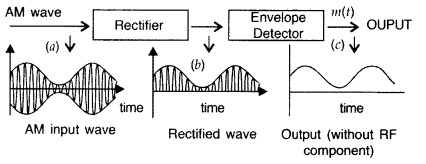
Question 92.
Write two basic modes of communication. Explain the process of amplitude modulation. Draw a schematic sketch showing how amplitude modulated signal is obtained by superposing a modulating signal over a sinusoidal carrier wave. (All India 2013)
Answer:
The two basic modes of communication are :
(1) point-to-point communication
(2) broadcast communication
Amplitude modulation. It is produced by varying the amplitude of carrier waves in accordance with the amplitude of the modulating wave.
Production of amplitude modulated wave. A conceptually simple method to produce AM wave is shown in block diagram.
Question 93.
Draw a block diagram of a detector for AM signal and show, using necessary processes and the waveforms, how the original message signal is detected from the input AM wave. (Delhi 2015)
Answer:
Detection of a modulated signal: Detection is the process of recovering the modulated signal from the modulated carrier wave. The modulated carrier wave contains the frequencies ωc, (ωc + ωm) and (ωc – ωm). In order to obtain the original message signal m (+) of angular frequency ωm following simple method is shown in the form of a block diagram.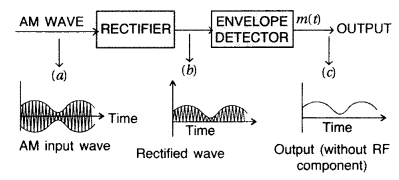
Question 94.
Define modulation index. Why is its value kept, in practice, less than one?
A carrier wave of frequency 1.5 MHz and amplitude 50 V is modulated by a sinusoidal wave of frequency 10 kHz producing 50% amplitude modulation. Calculate the amplitude of the AM wave and frequencies of the side bands produced. (All India 2015)
Answer:
(i) Definition of Modulation Index. It is defined as the ratio of the amplitude of modulating signal (Am) to the amplitude of carrier wave (Ac)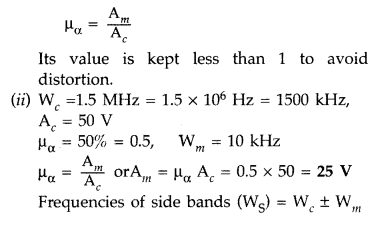
= (1500 kHz ± 10 kHz)
= 1510 and 1490 kHz respectivley.
Question 95.
Answer the following questions:
(i) Why is the thin ozone layer on top of the stratosphere crucial for human survival? Identify to which a part of electromagnetic spectrum does this radiation belong and write one important application of the radiation.
(ii) Why are infrared waves referred to as heat waves? How are they produced? What role do they play in maintaining the earth’s warmth through the greenhouse effect? (Comptt. Delhi 2015)
Answer:
(i) The thin ozone layer on the top of stratosphere is crucial for human survival, because it absorbs ultraviolet radiations from the Sun and thus prevents them from reaching the earth’s surface causing damage to life.
Identification : ultraviolet radiations. Its correct application is Sanitization.
(ii) (a) Water molecules present in most materials readily absorb infra red waves. Hence, their thermal motion * increases. Therefore, they heat their surroundings and are hence referred to as heat waves.
(b) They are produced by hot bodies and molecules.
(c) Incoming visible light is absorbed by earth’s surface and radiated as infra red radiations. These radiations are trapped by green house gases.
Question 96.
(a) Given a block diagram of a generalized communication system.
Identify the boxes ‘X’ and ‘Y’ and write their functions.
(b) Distinguish between “Point to Point” and “Broadcast” modes of communication. (Comptt. Delhi 2015)
Answer:
(a) X : Transmitter Y : Channel Their function:
Transmitter : To convert the message signal into suitable form for transmission through channel.
Channel : It sends the signal to the receiver.
(b) In point to point mode, communication takes place between a single transmitter and receiver while in broadcast mode, large number of receivers are connected to a single transmitter.
Question 97.
Explain the following terms in relation to the use of internet :
(i) Internet surfing
(ii) Social networking
(iii) E-mail (Comptt. Delhi 2015)
Answer:
(i) Internet surfing : “It is the exploration of me world wide web (www) by following one interesting link to another one usually without a definitive object or search strategy, through the internet.”
(ii) Social networking : It is a platform to build social networks or social relations among people who share similar interests, activities, backgrounds or real life connections. A social network service consists of a representation of each user (often a profile), his or her social links, and a variety of services.
(iii) E-mail : E-maii (Electronic mail) is a method of exchanging digital messages from an author to one or more recipients. E-mail operates across the internet or other complex networks. E-mail servers accept, forward, deliver and store messages.
An internet Email message consists of these components :
(a) message envelope,
(b) message header and
(c) message body. Thus e-mail is an information and communications technology.
Question 98.
(a) Explain any two factors which justify the need of modulating a low frequency signal.
(b) Write two advantages of frequency modulation over amplitude modulation. (Delhi 2016)
Answer:
(a) Need of modulation : A low frequency signal is modulated for the following purposes :
(i) It reduces the wavelength of transmitted signal, and the minimum height of antenna for effective communication is
Therefore height of antenna becomes practically achievable.
(ii) Power radiated into the space by an antenna is inversely proportional to λ2. Therefore, the power radiated into the space increases and signal can travel larger distance.
(b) Advantages of frequency modulation :
- High efficiency
- Less noise .
- Maximum use of transmitted power.
Question 99.
(i) Which mode of propagation is used by shortwave broadcast services having frequency range from a few MHz upto 30 MHz? Explain diagrammatically how long distance communication can be achieved by this mode.
(ii) Why is there an upper limit to frequency of waves used in this mode? (All India 2015)
Answer:
(i) (a) Sky wave propagation
(b)
Three different modes of propagation used in communication are :
- Space wave propagation.
- Ground wave propagation
- Sky wave or ionospheric propagation
The radio waves of the high frequency band having frequency range 3-30 MHz cannot penetrate through the ionosphere. They are reflected back towards the earth. This region of the AM band is called shortwave band. Above 40 MHz, the ionosphere bends the electromagnetic waves and does not reflect them back towards the earth.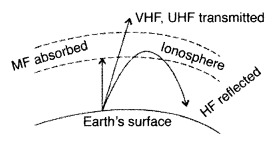
(ii) Electromagnetic waves of frequencies higher than 30 MHz, penetrate the ionosphere and escape whereas the waves less than 30 MHz are reflected back to the earth by the ionosphere.
Question 100.
What does the term ‘Modulation’, used in communication system, mean?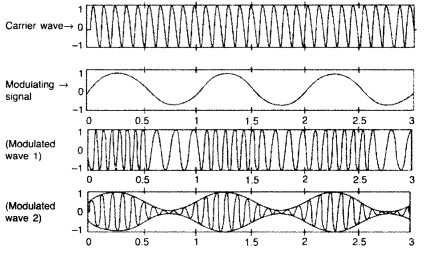
Identify the two types of modulation shown here. Give two advantages of any one of these over the other. (Comptt. Delhi 2015)
Answer:
(i) Modulation is a process in which one of the characteristics (amplitude, frequency, phase) of a high frequency carrier wave is made to change in accordance with a given low frequency message signal.
(ii) (a) Modulated wave 1 : Frequency Modulation (FM)
(b) Modulated wave 2 : Amplitude Modulation (AM)
Two advantages of FM over AM :
- Lower noise, better power efficiency.
- Higher operating range.
- Higher fidelity reception.
Two advantages of AM over FM :
- Simple circuits are required.
- Lower frequency space for transmission.
Question 101.
Give (brief) reasons for the following :
(a) We use the ‘sky wave’ mode of propagation, of electromagnetic waves, only for frequencies up to 30 to 40 MHz.
(b) The LOS communication, via space waves, has a (fairly) limited range.
(c) A mobile phone user gets an ‘uninterrupted link to talk’ while walking. (Comptt. All India 2015)
Answer:
(a) The ionosphere can act as a ‘reflector’ only for e.m. waves of frequencies upto 30 to 40 MHz. Higher frequency e.m. waves penetrate into the atmosphere and escape.
(b) The range is (fairly) limited because the e.m. waves lose energy (fairly rapidly) when they glide over the surface of the earth.
(c) This is because of the presence of a network of base stations’/cells’ which keep on passing the signals from one base station/cell to the other.
Question 102.
Define the term ‘amplitude modulation’.
Explain any two factors which justify the need for modulating a low frequency base-band signal. (Delhi 2017)
Answer:
‘Amplitude modulation’ is the process of superposition of information/message signal over a carrier wave in such a way that the amplitude of carrier wave is varied according to the information signal/message signal.
Direct transmission, of the low frequency base band information signal, is not possible due to the following reasons :
(i) Size of Antenna: For transmitting a signal, minimum height of antenna should be
(ii) Effective power radiated by an antenna :
Effective power radiated by an antenna varies inversely as λ2, hence effective power radiated into the space, by the antenna, increases.
(iii) To avoid mixing up of signals from different transmitters.
Question 103.
(a) How is amplitude modulation achieved?
(b) The frequencies of two side bands in an AM wave are 640 kHz and 660 kHz respectively. Find the frequencies of . carrier and modulating signal. What is the bandwidth required for amplitude modulation? (All India 2017)
Answer:
(a) Amplitude modulation is achieved by applying the message signal, and the carrier wave, to a non-linear (square law device) followed by a band pass filter as shown below in the block diagram: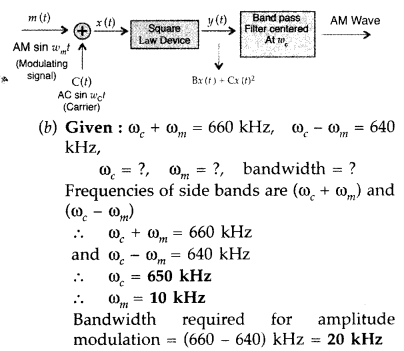
Question 104.
Draw a block diagram of generalized communication system. Write the functions of each of the following:
(a) Transmitter
(b) Channel
(c) Receiver (All India 2017)
Answer:
Block diagram of generalized communication system :
Functions:
(a) Transmitter : A transmitter processes the incoming message signal so as to make it suitable for transmission through a channel and subsequent reception.
(b) Channel: It carries the message signal from a transmitter to a receiver.
(c) Receiver : A receiver extracts the desired message signals from the received signals at the channel output.
Question 105.
Explain the term, ‘amplitude modulation’ of a signal. For an amplitude modulated wave, the maximum amplitude is 10 V and the minimum amplitude is 2 V. Calculate the modulation index. (Comptt. Delhi 2017)
Answer:
Amplitude modulation is the process of superposition of a message signal over a carrier, wave in which amplitude of the carrier wave is varied in accordance with the message/ information signal.
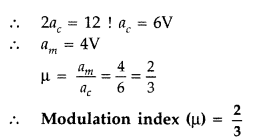
Question 106.
Distinguish between sky wave and space modes of communication. What is the main limitation of space wave mode? Write the expression for the optimum separation between the transmitting and receiving antenna for effective reception of signals in this mode of communication. (Comptt. Delhi 2017)
Answer:
(i) In sky wave mode of communication, waves reach from transmitting antenna to receiving antenna through reflections from ionosphere; while in space wave mode of communication, waves travel either directly from the transmitter to receiver or through satellites.
(ii) Direct waves get blocked at some point due to the curvature of earth.
(iii) Optimum distance between transmitting and receiving antenna![]()
Question 107.
Explain the meaning of terms : Attenuation and Demodulation. For an amplitude modulated wave, the maximum amplitude is 12 V and the minimum amplitude is 2 V. Calculate the modulation index. (Comptt. Delhi 2017)
Answer:
Attenuation : It is the loss of strength of signal, while propagating through a medium.
Demodulation : It is the process of recovery of audio signal from the modulated wave.
Question 108.
Write the functions of
(i) Repeater and
(ii) Receiver. For an amplitude modulated wave, the maximum amplitude is 15 V and the minimum amplitude is 3 V. Calculate the modulation index. (Comptt. Delhi 2017)
Answer:
Repeater is a combination of a receiver and a transmitter. It is used to increase the range of communication of signals. A repeater picks up the signal from the transmitter, amplifies it and retransmits it to the receiver.
Receiver extracts the desired message signals from the received signals at the channel output. It is the combination of receiving antenna, amplifier, intermediate frequency converter, demodulator and amplifier of audio signal.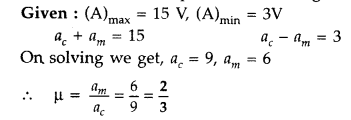
Question 109.
Briefly explain the three factors which justify the need of modulating low frequency signal into high frequencies. (Comptt. All India 2017)
Answer:
(a) Modulation is needed
- to transmit a low frequency signal to a distant place.
- to keep the height of antenna small.
- not to allow the signals from different stations getting mixed up.










